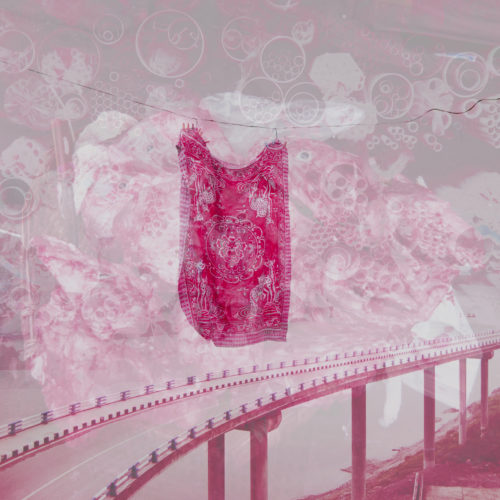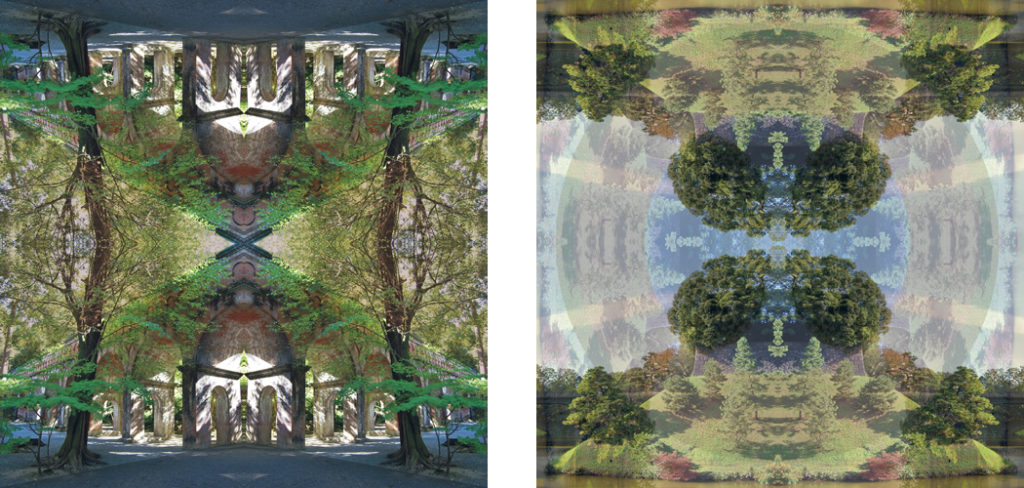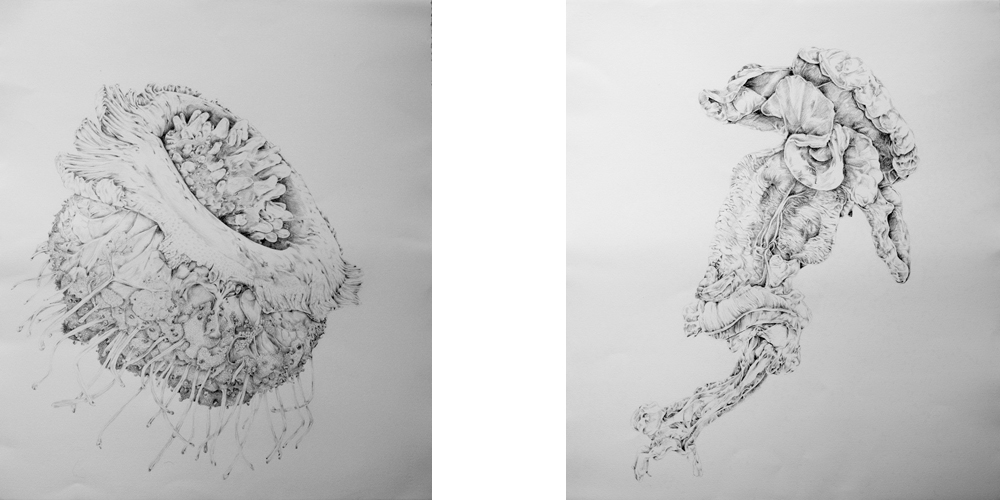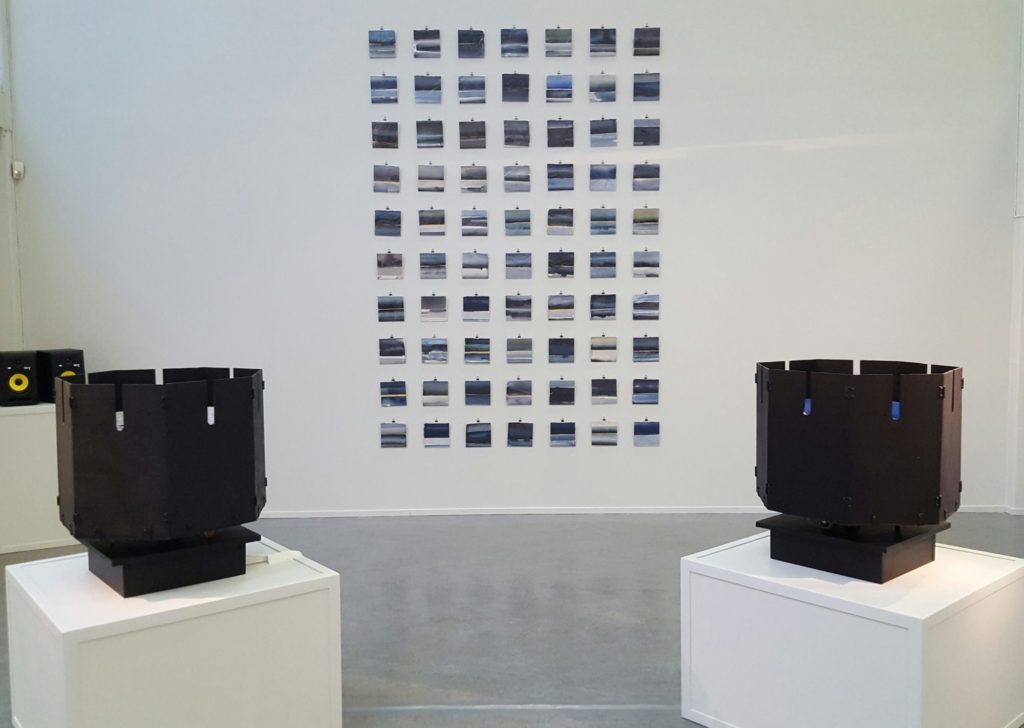Interdisciplinary Art Installation by Bettina Hvidevold Hystad & Simon Torssell Lerin
January 21st-March 18th 2017
‘Creatures of the Deep’ is the title of an assembly of several works of art created and displayed by the artist duo Lerin/Hystad, in one multi media installation. The exhibition consists of two series of photographs from Japan and China, a series of pencil drawings with motives from various marine locations around the world, four audiovisual mechanical zoetropes and 70 watercoulours in plastic sleeves containing a vinyl record in each pocket.
The exhibition functions as a multi-disciplinary creative documentation of contemporary journeys the artist duo experienced together. The aesthetic audiovisual assemblage of work is created by the artists, by traditional and progressive methods. It shows photography, drawing, sculpture and sound in various ways that takes us on a journey with them, through geographical as well as aesthetic and art historical landscapes.
A series of 18 photographs from Japan titled Amaterasu, shows a focus on gardens and japanese architecture. They are manipulated i various ways by mirroring and doubling the images to form kaleidoscopes. The images are individually printed in colour on metal sheets, each sized 50 x 50 cm. The inspiration for this series of photographs, was the well coiffed gardens typical of Japanese culture. The very organized and symmetrical obsession of order that the Japanese society displays, has for centuries inspired other cultures especially within the field of gardens and landscapes. This tradition was initially taken forward by the Italians during the late Renaissance and unfolded manieristically duiring the 1600s both in Italy and in France with elaborate gardens, fountains, labyrinths and trompe l’oeil architectural features in grand houses and estates. In the 1800s this was developed further by the British during the reign of Queen Victoria, when the British empire expanded with colonization in the world.
The cultures of the far east was explored together with the conquest of resources. At the same time, the first colour photograph was printed in Glasgow by the Scottish scientist James Maxwell in 1861. Bettina Hystad spent some time at art school in Glasgow, Scotland, 2009, which may have influenced some traits of inspiration for her later photographic work and exploration.
Bettina Hystad also exhibits a series of meticulously executed pencil drawings on paper in the large format of approximately 70x 60cm. The drawings partly represents underwater creatures like jellyfish and other marine life species. Other drawings document plastic bags and similar objects, found floating in the sea. At first sight these might look like organic marine life, but are in fact artificial waste material from human production and activity. According to the artist, the drawings took approximately one week each, to complete. Each drawing is individually displayed directly under glass within a frame. The series is exhibited on the walls in the gallery space with four zoetropes and Simon Lerins watercolours of marine life and nordic landscapes.
A series of 70 watercolours hang in a symmetrical grid, 7 across x 10 high. These renderings are fragments of Svartvatnet, a lake in northern Norway by Lofoten. In this area the sun disappears for several months during winter. The location is almost at the end of the world. The landscape we see here has not changed much in thousands of years. People are absent from the paintings. We see the water, the horizon and the sky in various shades of cobolt and prussian blue. The white paper shines through in smaller parts of the pictures, as streams of light. The light is scaresly present. Each watercolour carry similarities to the rest, as fragments of the same image. But in a few of the paintings, a bright yellow stream of light appears just above the horizon. A reminder of how the sun returns after a long dark winter. The same yellow colour is used in printing the vinyl record, which sits in the pastic sleeve behind the painting. It is not visible in the exhibition, but rather hidden from view. The watercolours in the transparent sleeves become record-covers, where the plastic pockets hold both a cover and a recording of music, composed around the theme of the landscape. The amount of audiovisual pockets on display varies, according to how many are sold at each exhibition. The edition started at 100 copies of the record, where each 100 watercolours function as a cover but are unique, individual and original works of art. Each plastic sleeve hangs from a nail on the wall by office paper clip. This particular way of hooking the artwork onto the nails, provides an easy approach towards taking the pieces down when sold. It supports the idea of distribution and hints at commercial value. The record industry favours large quantities of copies for the purpose of making money. A musical composition can be easily downloaded from the internet these days. But vinyl records have seen a renaissance lately and are back in style for collectors. The analogue sound is again favoured in comparison with digital recordings. The artists are also musicians and their vinyl records and CDs are available for sale online and at the gallery.
Simon Lerins body of work Svarvatnet, sits on a high wall and forms a backdrop for the zoetropes and Bettina Hystads marine pencil drawings. The set of four Zoetropes built by Lerin/Hystad remind us of a time before film was produced on a large scale.
The zoetrope was a significant forerunner and represents the first steps towards moving pictures in the world. It was first invented in China and later re-created in the Victorian era of Europe. Within the interior drum of the zoetropes, Lerin has painted marine life and landscapes of the north, on rolls of aquarelle paper. His watercolours display whales, school of fish, mountains and squid in repetitive patterns. Lerin/Hystad have built the mechanical zoetropes out of wood, thereby sticking to the original approach towards creation of the device. The sound of the zoetrope is created by the mechanical machinery turning slowly around its own axis, powered by electricity. Lerin has previously recorded the analogue zoetrope sound and transformed it digitally through a synthesizer. The sound picture from this transformed recording can be heard through speakers in the room as part of the installation. The audiovisual experience of the assembly is meditative in its form, with the repetition of images and sound. The composition of the installation can be described as interstitial on account of the spaces within the different dimensions of the art work. There is a profound duality between the negative space and the created pieces that appears of equal value to each other. The dynamic installation becomes an actual constellation of material forms, integrated within the gallery space and architecture.
The exhibition questions the development of the industrial world which started with the Victorian ethos in the early 1800s, of cultivating the natural world in a way that served us humans in our quest for resources. This quest connected to the material world of things, are now mass produced in order to keep up with the demands of the capitalistic market and the corporate world. The commercial focus shows us how we at this point are realizing the high price we are paying for exploitation of the earth and its people. The quest for resources and mass production of industrial material on a large scale, are exhausting and polluting our planet. The extreme demand for resources and exploitation of human life can be found in its most visual form in China.
Lerin/Hystad spent a month in China as artists in residence. In Chongqing, a town of 30 000 000 inhabitants, the artist duo walked around in observation of the landscape and integrated with the people. The photographs they captured from the surroundings of Chongqing are visual documentations of a culture experiencing dramatic contrasts. It is a place where rural traditional lifestyle meets high frequency urban developments on every level of existence. The photo series titled Mount Bhozou, are visually manipulated by altering the colours and layering various photos over each other. The artists felt that in a place where everything happened at the same time, it was the best way to portray the immediate environment. People were living in sheds, hanging out their laundry in between the high rise buildings. Living on boats carrying goods or sand to be released into the river. The pastel colours appear romantic in a diffused dream like light. The boats alsmost look like small cruise ships in the seductive colour scheme of pink, light blue, mint green and soft yellow. But they are not. The reality here is harsh. Poverty and pollution prevails over the landscape, where nature has lost the battle of existence with the corporate industry’s overpowering force. ‘Creatures of the deep’ is a reminder of the eternal values of myth, where nature and landscape meets human activity on many levels of survival, within a multitude of traditions. Simoultanously, the Lerin/Hystad installation underlines and reinforces the value of architecture and presentation. The open cubical space of the art gallery at Kunstmuseet Nord-Trøndelag in Norway, lends itself very well to the intriguing assemblage of their exhibition.
Ingeborg P. Bodzioch, Museum Educator, Kunstmuseet Nord-Trøndelag, Museet Midt IKS





